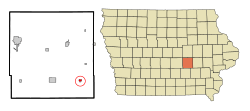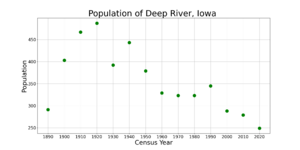Deep River, Iowa facts for kids
Quick facts for kids
Deep River, Iowa
|
|
|---|---|

Location of Deep River, Iowa
|
|
| Country | |
| State | |
| County | Poweshiek |
| Area | |
| • Total | 0.44 sq mi (1.13 km2) |
| • Land | 0.44 sq mi (1.13 km2) |
| • Water | 0.00 sq mi (0.00 km2) |
| Elevation | 909 ft (277 m) |
| Population
(2020)
|
|
| • Total | 249 |
| • Density | 569.79/sq mi (219.79/km2) |
| Time zone | UTC-6 (Central (CST)) |
| • Summer (DST) | UTC-5 (CDT) |
| ZIP code |
52222
|
| Area code(s) | 641 |
| FIPS code | 19-19495 |
| GNIS feature ID | 0455847 |
Deep River is a small city located in Poweshiek County, Iowa, in the United States. It's also the name of the larger area, called a township, that the city is part of. In 2020, about 249 people lived in Deep River.
Contents
Where is Deep River Located?
Deep River is found in the state of Iowa. Its exact location is at coordinates 41.58 degrees North and 92.37 degrees West. The city covers a total area of about 0.43 square miles (1.13 square kilometers), and all of it is land.
The Deep River flows nearby. It is a smaller stream that eventually joins the English River. The town and the river were named "Deep River" not because the water itself is very deep, but because the river flows through a deep valley or ravine. In some places, the banks of the river are 20 feet (about 6 meters) above the normal water level.
In May 1970, the Deep River area experienced a big flood. The water level reached a record high of 83.85 feet (25.56 meters). This kind of flood happens less than once every 50 years.
A Look Back in Time: Deep River's History
The story of Deep River began in 1856 with a town called Dresden. It was located about a mile east of where Deep River is today. The Whitney brothers ran a store there for around 20 years.
When the Chicago and North Western Railway built a new train line, the people of Dresden decided to move closer to the railroad. This is how the town of Deep River was started in 1884. The old Dresden Cemetery is still located about a mile and a half south of the Diamond Trail road.
How Deep River Township Started
Deep River Township was officially formed on March 7, 1857. Before that, it was part of another area called Jackson Township. The township got its name from the stream that runs through its northern part. It was called "Deep River" because the water was so far down in the valley, not because the water itself was very deep.
The first families to settle in Deep River Township arrived around 1849. These included Robert Taylor and his family from Ohio, John Sargood, Albert Morgan and his family, and the Lights from Virginia. The first post office in the area was set up in 1852 and was also called Deep River. The first marriage recorded was Nancy Taylor to Rev. W. H. Palmer in 1849.
In 1857, the first township election was held. People chose officers like trustees, a clerk, justices of the peace, constables, and a road supervisor.
The Town of Deep River Grows
The town of Deep River officially became a city in the summer of 1887. This happened after the Northwestern Railroad built a special track from Belle Plaine to Muchakinock. Horace Phelps helped make sure the train station was built in Deep River by building a depot and giving the railroad $1,500.
Soon, people from Dresden moved to the new town of Deep River, and Dresden became mostly empty. The first election for the town of Deep River chose its first leaders. J. S. Potter became the Mayor, and other important roles like recorder, treasurer, and councilmen were also filled.
How Many People Live Here?
The number of people living in Deep River has changed over the years. Here's a quick look at the population from different census counts:
- 1890: 291 people
- 1900: 403 people
- 1910: 467 people
- 1920: 487 people
- 1930: 392 people
- 1940: 443 people
- 1950: 379 people
- 1960: 329 people
- 1970: 323 people
- 1980: 323 people
- 1990: 345 people
- 2000: 288 people
- 2010: 279 people
- 2020: 249 people
Deep River in 2020
In 2020, the city had 249 residents living in 103 households. About 73 of these were families. The city had about 569 people per square mile. Most of the people living in Deep River (99.6%) were White. A small number (2.0%) were of Hispanic or Latino background.
About 37.9% of households had children under 18 living with them. The average age of people in Deep River was 40.3 years old. About 26.1% of residents were under 20, and 16.5% were 65 or older. The population was almost evenly split between males (48.6%) and females (51.4%).
Schools in Deep River
Most of Deep River is part of the Montezuma Community School District. A smaller part of the city is in the English Valleys Community School District.
Years ago, Deep River had its own school district called Deep River–Millersburg Community School District (DR-M). This district was created in 1958. In 1992, the district closed its high school. Students in junior high and high school then went to schools in either the English Valleys or Montezuma districts. The Deep River elementary school also closed that year, and younger students went to school in Millersburg.
On July 1, 2009, the DR-M district officially joined the English Valleys district. However, a small part of it became part of the Montezuma district instead.
See also
 In Spanish: Deep River (Iowa) para niños
In Spanish: Deep River (Iowa) para niños


